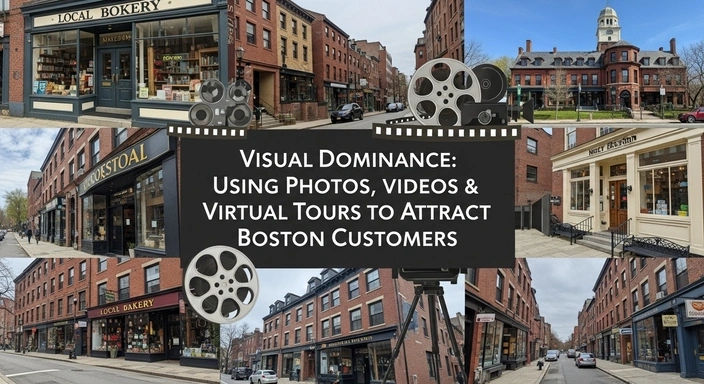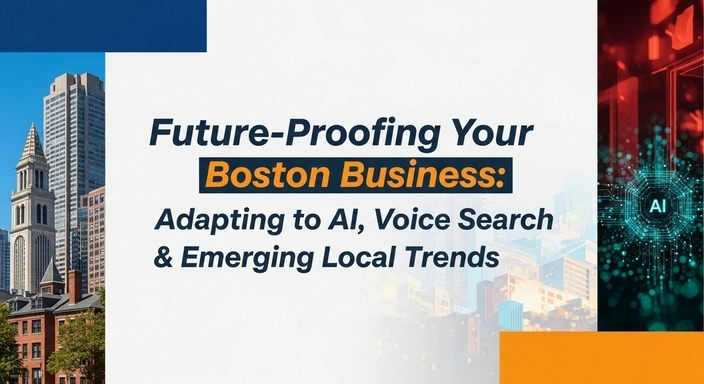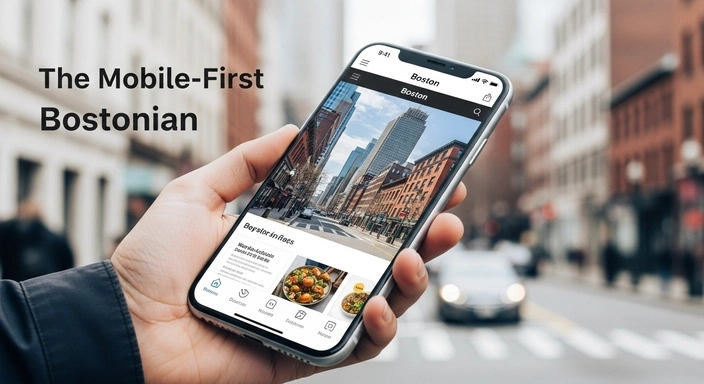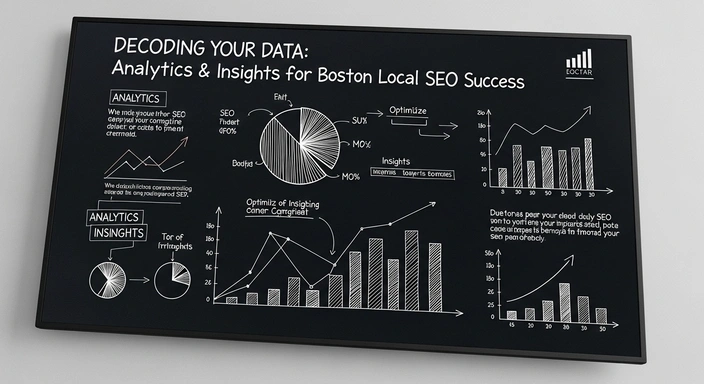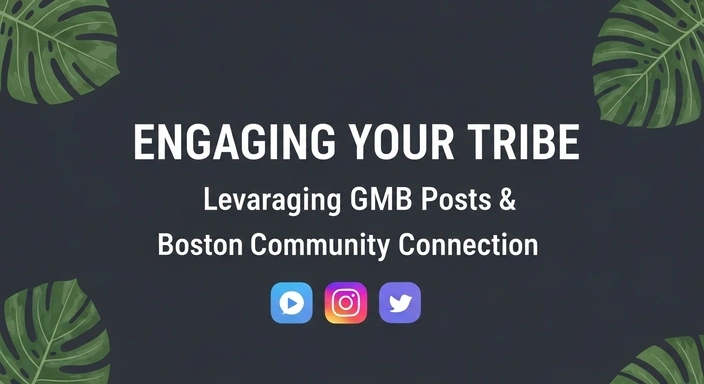This article is the eighth in our 12-part series: Beyond the Boom: How Boston Businesses Can Dominate Local Search & Drive Foot Traffic in a Shifting Economy. If you missed the previous essential guides, catch up on Beyond Yelp: Cultivating a Five-Star Reputation with Boston Customer Reviews, Discover the full series here.
In our rigorous pursuit of local digital dominance for Boston businesses in 2025, we’ve systematically constructed a robust framework: analyzing economic shifts, perfecting Google Business Profile (GBP) optimization, dissecting hyper-local search intent, mastering geo-targeting, cultivating five-star reputations, earning authoritative local links, and crafting hyper-local content that converts. Each of these pillars is crucial, forming the scaffolding for your online presence. Now, we arrive at a profoundly impactful and often underestimated pillar of local SEO: **Visual Dominance.** In a world increasingly saturated with information, where attention spans are fleeting and competition for digital real estate is fierce, compelling imagery, dynamic video content, and immersive virtual experiences cut through the noise, captivate audiences, and speak volumes about your brand’s authenticity, quality, and unique appeal. For a city as picturesque, historic, and vibrant as Boston, leveraging powerful visuals isn’t just a best practice; it’s a strategic imperative to attract, engage, and convert discerning customers.
Consider the modern Bostonian’s decision-making process. Searching for “best seafood restaurant Seaport” on their smartphone, they’ll likely scan the Google Maps results. What makes them click on one business over another, even before checking reviews? Often, it’s the enticing, high-resolution photo of a perfectly plated dish, a vibrant interior shot that conveys ambiance, or a brief video showcasing the lively atmosphere. Similarly, a resident looking for a “hair salon in Beacon Hill” might prioritize a salon with a virtual tour that allows them to experience the space and its aesthetic before they even step foot inside, building confidence and alignment. A parent searching for “daycare near Fenway Park” will be heavily influenced by photos of clean facilities and happy children.
The human brain processes visuals at an astonishing speed—60,000 times faster than text. This inherent cognitive advantage makes visual content profoundly impactful for first impressions and rapid decision-making. Moreover, Google’s algorithms, powered by advanced AI and sophisticated computer vision technologies, are increasingly adept at understanding, evaluating, and prioritizing visual content. They don’t just see a picture; they analyze its quality, relevance, context, sentiment, and authenticity. Visuals directly influence your prominence in local search results, contribute powerfully to your E-E-A-T (Experience, Expertise, Authoritativeness, Trustworthiness), and provide invaluable context for complex local search queries. Research consistently demonstrates the undeniable power of visual content: businesses with over 100 images on their GBP listing see significantly higher direction requests and website clicks, and profiles with videos can see 36% more engagement. In the era of pervasive visual search, AI Overviews (SGE), and the declining attention span, your visual assets are no longer supplemental; they are foundational search signals and powerful conversion tools.
This comprehensive guide will deep dive into the art and science of achieving visual dominance for Boston businesses. We will meticulously explore the critical types of photos, videos, and virtual tours that most effectively resonate with local audiences, unveil cutting-edge optimization strategies for both your Google Business Profile and your website, delve into the crucial technical SEO nuances of visual content, and illuminate how Google’s AI processes and ranks these vital assets. Mastering visual dominance ensures your Boston business captivates, convinces, and converts, transforming passive searches into active, high-value customer interactions and cementing your brand as a visually compelling leader in the Boston market.
—
The Paramount Importance of Visual Content in 2025: Speaking Volumes Without Words
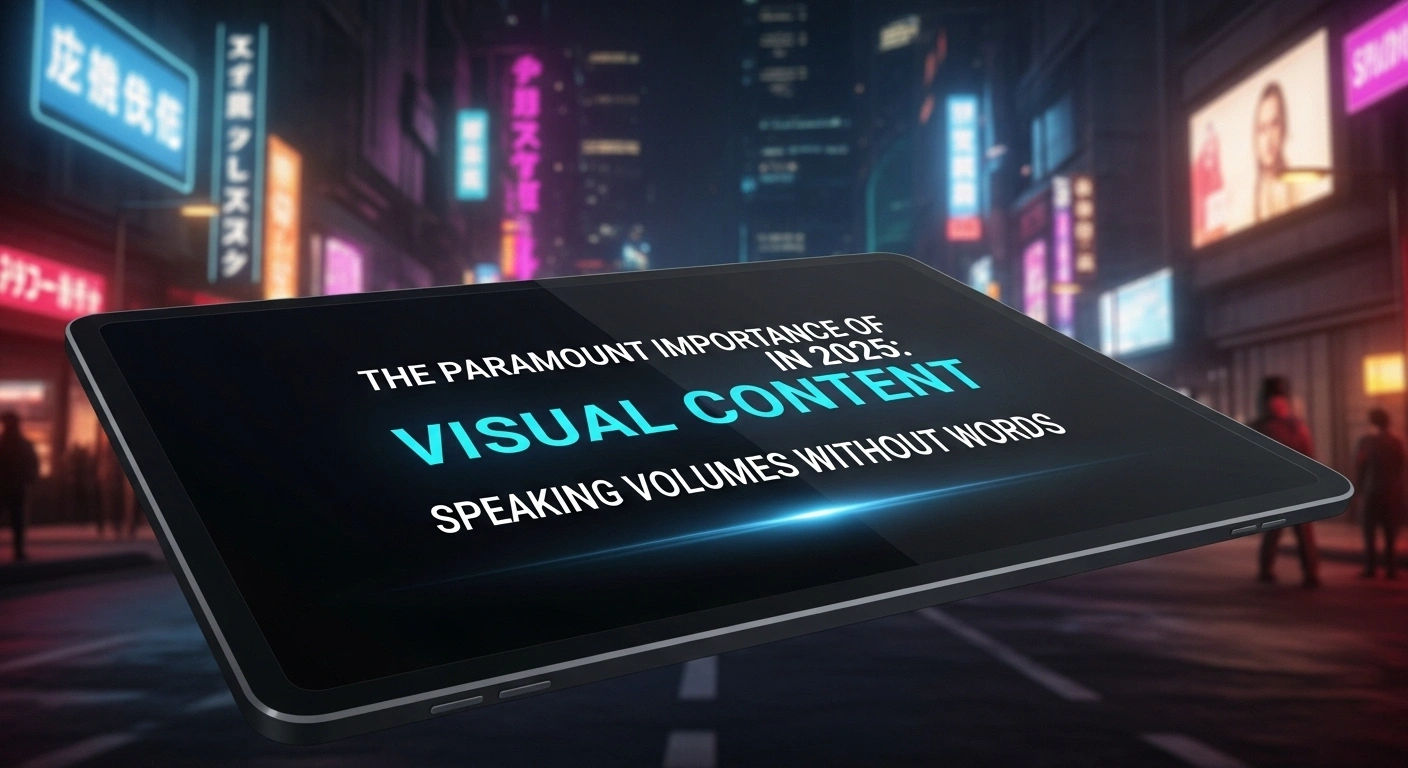
In an increasingly visual and fast-paced digital world, images and videos have transcended their traditional role as mere embellishments. They are now indispensable tools for communication, persuasion, and, crucially, local SEO. For Boston businesses, a robust and strategic visual content strategy is a direct, high-impact path to enhanced discoverability, increased user engagement, stronger brand affinity, and ultimately, higher conversion rates.
1. Captivating Attention & Forging Powerful First Impressions
In a digital landscape saturated with information, your ability to capture and hold a user’s attention is paramount. Visuals excel at this. In a cluttered search results page, a bustling Google Maps interface, or a rapidly scrolling social media feed, a compelling image or a dynamic video is your immediate hook. For a Bostonian scanning results on their mobile device, making rapid decisions:
- Instant Recognition & Wayfinding: A clear, high-quality photo of your storefront, complete with visible signage, helps customers instantly recognize your physical location upon arrival. For a business nestled in the historic, often confusing, streets of the North End or Beacon Hill, this visual wayfinding is invaluable.
- Emotional Connection & Atmosphere: High-quality visuals evoke emotion and convey the unique atmosphere and brand personality of your space. Imagine the cozy warmth of a Beacon Hill café on a snowy day, the sleek, innovative design of a Seaport tech office, the lively bar area of a Faneuil Hall pub, or the serene calm of a Back Bay wellness studio. These visuals create an emotional resonance that text alone struggles to achieve.
- Pre-Visit Experience & Expectation Setting: Visuals allow potential customers to “experience” your business before they physically visit, setting realistic expectations and building a sense of familiarity and comfort. This is particularly valuable for businesses like restaurants (showcasing cuisine and dining ambiance), salons (showing interior design and stylist work), retail stores (displaying product ranges and store layout), or medical/professional offices (conveying professionalism and comfort).
- Cutting Through Noise: In an attention economy, visuals cut through textual clutter. With short-form video seeing 120% higher engagement compared to static images on social media, dynamic visuals are the key to capturing and holding attention.
In mere seconds, visuals communicate professionalism, quality, and what a customer can authentically expect, directly influencing their decision to click, call, or visit.
2. Driving Engagement & Boosting Prominence on Google Business Profile (GBP)
Google Business Profile (GBP) is heavily skewed towards visual content, recognizing its unparalleled power to engage users and provide rich context. Active visual content directly and significantly contributes to your “Prominence” score, a core local ranking factor (as meticulously detailed in Post 4). This translates into higher visibility in local search results.
- Increased User Actions: Statistics unequivocally demonstrate the impact of visuals. Businesses with over 100 images on their GBP listing see significantly higher direction requests and website clicks. This indicates that a rich, comprehensive visual profile is directly correlated with actionable customer engagement and conversions.
- User-Generated Content (UGC) Amplification: Google actively encourages users to upload their own photos and videos to GBP. This user-generated content (UGC) is incredibly powerful. It signals authenticity, popularity, and genuine customer experiences, further boosting your prominence and trustworthiness in the eyes of Google’s algorithms and other users.
- The Power of Video: Beyond static images, video content offers a richer, more dynamic experience, showcasing your business in motion. Studies consistently show that GBP listings with videos can see 36% more engagement. Videos can convey atmosphere, service processes, and team personality in ways photos cannot.
- Immersive Virtual Tours: Professional 360° virtual tours significantly increase dwell time on your GBP. They help customers feel comfortable and confident visiting your physical location before they arrive, reducing perceived risk and directly influencing conversion rates. Businesses with virtual tours often achieve higher engagement and better local pack visibility, as they provide an unparalleled pre-visit experience.
Google’s recent GBP updates in 2025, including testing product tags on photos, new options for reporting reviews, and experimental “Story format” for reviews, further underscore their profound commitment to visual content as a primary engagement driver and ranking signal (EmbedSocial, Studio1Hub).
3. Enhancing E-E-A-T: Visuals as Tangible Demonstrations of Trust & Expertise
Visual content directly and powerfully contributes to your E-E-A-T (Experience, Expertise, Authoritativeness, Trustworthiness) signals, which are paramount for Google to confidently recommend your business, especially for YMYL (Your Money Your Life) sectors prevalent in Boston (e.g., medical, legal, financial services). Visuals provide tangible proof, not just claims.
- Experience: Photos and videos showcasing your team actively performing services, creating products, or interacting with customers provide undeniable proof of your real-world experience. A Boston general contractor’s meticulous before-and-after shots of historic brownstone renovations, or a Back Bay dental practice showing a patient consultation in a modern, clean facility, are powerful visual testaments to their experience and capabilities.
- Expertise: Videos demonstrating a complex process, detailed product shots highlighting craftsmanship, or images of your team’s certifications and awards prominently displayed can visually convey deep expertise. A biotech consulting firm might use a video to explain a complex scientific process, thereby showcasing their technical prowess.
- Authoritativeness: Professional, high-quality, and consistent visuals across all platforms signal a reputable, well-established, and authoritative business. Images of local awards, community involvement, or features in local media outlets can visually reinforce your authority within the Boston community.
- Trustworthiness: Authentic photos of your actual team and your premises build transparency and profound trust. Avoiding generic stock photos is critical, as they can undermine credibility. High-quality, real visuals simply make your business appear more reliable, credible, and worthy of customer confidence. Google’s AI is increasingly adept at detecting visual authenticity versus generic or manipulated imagery.
4. Optimizing for Visual Search & AI Overviews (SGE): Future-Proofing Your Presence
The landscape of search is rapidly evolving beyond text. Visual search, where users search directly with images, and Google’s AI Overviews (SGE), which synthesize information including relevant visuals, place new and critical demands on your visual strategy for 2025 and beyond.
- Visual Search Platforms (e.g., Google Lens): Platforms like Google Lens allow users to search for products, landmarks, or information using their camera. Optimizing your images (with detailed alt text, descriptive file names, and relevant context) means your products or services could be discovered directly from a photo someone takes, whether it’s a unique storefront sign in the North End or a specific type of plant in a Public Garden landscape design.
- AI Overviews (SGE) & Visual Synthesis: Google’s generative AI can pull relevant images and videos directly into AI Overviews to provide more comprehensive and visually engaging answers. If your visuals are well-optimized, highly relevant, and uniquely informative, they are significantly more likely to be featured, extending your brand’s reach even in a “zero-click” environment. Google’s AI assesses not just keywords but visual context, quality, and originality to determine which visuals are most helpful for a user’s query. This means your images must be clear, representative, and directly answer aspects of the user’s implicit or explicit visual intent.
- The Rise of Multi-Modal AI: Google’s AI models (like Gemini) are increasingly multimodal, meaning they can understand and integrate information from various formats—text, images, audio, video. This holistic understanding means your visual content contributes to your overall ranking signals in ways that text alone cannot, by providing richer context and validating claims.
High-quality, meticulously optimized visuals are thus essential for future-proofing your SEO strategy in an increasingly AI-driven and visually dominant search ecosystem. They serve as direct signals of your business’s real-world relevance and quality.
—
Types of Visual Content for Boston Businesses: Capturing Every Angle & Aesthetic
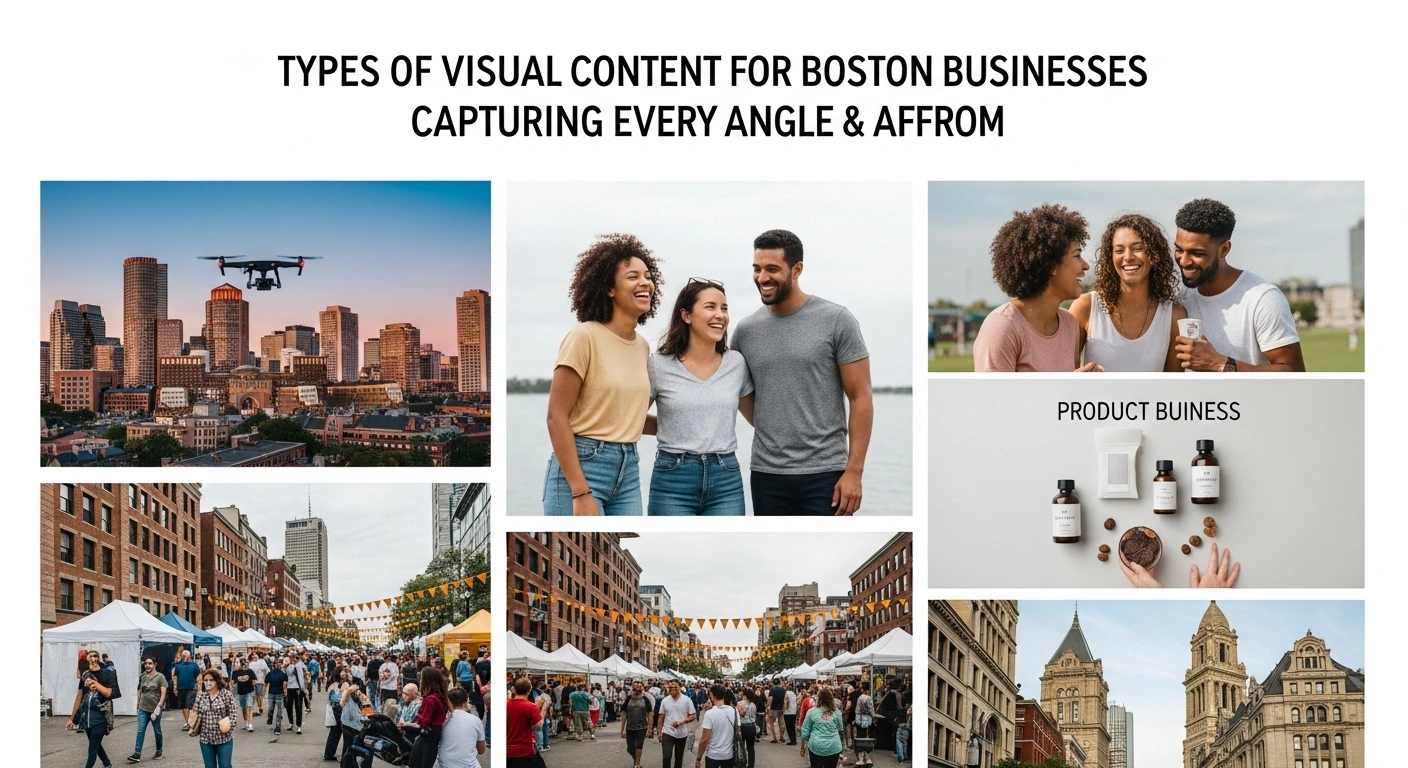
To achieve visual dominance, a diverse, authentic, and strategically planned array of photos, videos, and immersive virtual tours is essential. Each type serves a unique purpose, contributing to a comprehensive visual narrative of your Boston business and captivating different facets of user intent. Always prioritize high-resolution (at least 720p on the shorter side), well-composed, and professionally lit visuals.
1. High-Quality Photos: The Foundational Visual Assets
Photos are the most accessible and versatile form of visual content. Invest in professional photography (or learn advanced DIY techniques) that genuinely captures the essence of your Boston business and its unique offerings. Google recommends minimum photo resolution of 720px on the shorter side, with file sizes between 10KB and 5MB. Authenticity is paramount; avoid generic stock photos.
- Exterior Shots: Your Digital Curb Appeal & Wayfinding.
- Clear Signage: Your main exterior shot should clearly display your business name and logo, making it easy for customers to identify you upon arrival. Ideally, it should match what’s visible on Google Street View for consistent wayfinding.
- Contextual & Neighborhood-Specific: Include photos that subtly feature nearby Boston landmarks or recognizable street scenes. For a North End eatery, a photo with a glimpse of the Old North Church or a distinctive cobblestone street. For a Back Bay boutique, a shot with the brownstone architecture. This reinforces your exact location and aesthetic within the Boston fabric.
- Seasonal Variations & Time of Day: Showcase your business in different seasons (e.g., adorned for the holidays, vibrant with spring flowers along the Commonwealth Avenue Mall, cozy on a snowy Boston winter day). Also, consider photos during different times of day (e.g., a restaurant at bustling lunch vs. romantic dinner). This adds freshness and relevance.
- Accessibility Features: Visually demonstrate accessibility features (e.g., ramps, accessible entrances) for users filtering for such attributes.
- Interior Shots: Setting the Scene & Conveying Ambiance.
- Atmosphere: Capture the unique ambiance of your space. Is it the cozy, literary feel of a bookstore in Cambridge, the sleek, innovative design of a Seaport tech office, the lively energy of a pub near TD Garden, or the serene calm of a yoga studio in the South End?
- Cleanliness & Layout: Show a clean, inviting, and well-organized space. This builds immediate trust and sets positive expectations for an in-person visit.
- Key Features & Functionality: Highlight unique architectural elements (e.g., exposed brick in a historic North End eatery, a distinctive bar design), seating arrangements, specialized equipment, or unique decor that defines your brand.
- Operational Shots: If appropriate, show your space during operation, with staff interacting with customers (with consent) or products displayed.
- Product Photos: Showcase Your Offerings & Tempt the Customer.
- High-Resolution & Detail: For restaurants, capture beautifully plated dishes (e.g., a perfectly golden lobster roll, a vibrant clam chowder). For retail, provide close-ups of products from various angles, highlighting texture, material, and craftsmanship. For service industries, relevant tools or compelling “after” results.
- Authenticity: Use real photos of your actual products, prepared as they are served or sold. Avoid generic stock images at all costs. For a bakery in Southie, show your freshly baked pastries cooling on a rack. For a custom tailor, display the intricate stitching of your bespoke garments.
- Contextual Use: Show products being used by happy customers (with explicit permission) or in their intended environment (e.g., a piece of furniture in a stylish Boston living room setting, a user interacting with your software in a modern office).
- Product Tags (Emerging GBP Feature): Google is testing the ability to tag specific products directly within photos on GBP, making high-quality product imagery even more vital for direct conversion paths.
- Services in Action: Demonstrating Expertise & Process.
- Behind-the-Scenes: Photos of your team performing a service (e.g., a plumber expertly fixing pipes in a Boston home, a stylist cutting hair with precision, an accountant consulting diligently with a Financial District client). This builds trust by demystifying your process and visually explaining your offerings.
- Before-and-After: For renovation, landscaping, cleaning, or aesthetic services, compelling before-and-after photos are incredibly persuasive. A Boston general contractor showcasing a stunning renovation of a historic Victorian home in Dorchester, or a cleaning service demonstrating the transformation of a commercial space in the Seaport.
- Safety & Professionalism: For services, photos showing your team using proper equipment, wearing uniforms, and adhering to safety protocols can instill confidence.
- Team Photos: Building Trust, Connection & E-E-A-T.
- Authenticity & Approachability: Showcase your real team members. Photos of staff smiling, interacting with customers, or working collaboratively humanize your brand and build trust. This is crucial for small, local businesses in Boston where personal connection matters.
- Diversity & Inclusivity: Reflect the diverse community of Boston in your team photos. This resonates with a broader audience and signals an inclusive environment.
- Professionalism & Expertise: While authentic, photos should still be professional and well-composed. Consider including headshots with relevant credentials or action shots that highlight expertise.
- Community Involvement: Photos of your team volunteering at a local Boston charity event or participating in a neighborhood festival underscore your community commitment, enhancing Trustworthiness.
- User-Generated Content (UGC): The Most Authentic Proof.
- Encourage customers to upload their own photos to your GBP (e.g., photos of their meal, their new haircut, or their experience with your service). This UGC is highly authentic and Google prioritizes it, as it signals genuine customer interaction and satisfaction.
- Monitor and respond to UGC, thanking customers for their contributions.
2. Dynamic Video Content: Engaging & Informative Visual Narratives
Video content provides a richer, more dynamic, and immersive experience than static photos. It allows you to tell your story, showcase your personality, and convey complex information efficiently. Videos can be embedded on your website, shared on social media, and crucially, uploaded directly to your GBP. Google recommends video resolution of 720p or higher, up to 30 seconds long, and up to 75MB in file size for GBP uploads.
- Short-Form Videos (15-60 seconds): Quick Captivation.
- GBP Posts: Create short, engaging video clips for your Google Business Profile Posts to announce offers, events, or quick updates. They significantly boost engagement.
- Social Media Reels/Stories: Perfect for Instagram Reels, TikTok, and Facebook Stories. Showcase a quick facility tour, a product highlight, a “day in the life” of your Boston team member, or a brief “how-to” tip.
- Product/Service Highlights: A quick visual tour of a new menu item, a new retail product, or a brief demo of a service.
- “Meet the Team” Snippets: Brief, friendly introductions to key staff members in a conversational style.
- Long-Form Videos (2-10 minutes): In-Depth Engagement & Authority.
- Virtual Business Tours: A more comprehensive video walkthrough of your entire facility, showcasing different areas and amenities.
- Customer Testimonials: Capture genuine video testimonials from satisfied Boston clients. Seeing and hearing real customers provides immense social proof.
- Explainer Videos: Visually break down complex services or products in an easy-to-understand format. For example, a Boston law firm could create a video explaining complex zoning regulations.
- “How-To” Guides & Tutorials: Demonstrate your expertise by providing valuable “how-to” content (e.g., “How to Winterize Your Boston Home’s Pipes,” “Basic Bike Maintenance for Boston Commuters”).
- “Day in the Life” Videos: Offer a glimpse into your operational processes, showcasing your professionalism and dedication (e.g., a time-lapse of a Seaport construction project, or a “behind the scenes” of a busy North End restaurant kitchen).
- Event Recaps: Document your participation in local Boston events, showcasing your community involvement.
Host longer videos on YouTube (the world’s second-largest search engine) and then embed them on your website and GBP. YouTube optimization (keywords in titles, descriptions, tags, and custom thumbnails) is crucial for discoverability.
- Live Streams: Real-Time Engagement & Authenticity.
- Host live Q&A sessions, product launches, or behind-the-scenes tours relevant to your Boston audience. This fosters real-time interaction and builds a strong sense of community.
3. Immersive Virtual Tours: The Ultimate Pre-Visit Experience
For businesses with physical locations, particularly those where ambiance, layout, or cleanliness are crucial (e.g., restaurants, retail, hotels, medical clinics, event venues, gyms), a 360° virtual tour offers an unparalleled level of transparency and engagement. They provide an immersive pre-visit experience, building immense trust and confidence. The most impactful virtual tours are those integrated with Google Street View.
- Google Street View (Trusted Photographer Program): Professional 360° virtual tours linked directly to your Google Business Profile and Google Maps. These tours appear as part of Google Street View, allowing users to “walk through” your business. Hiring a Google Street View trusted photographer ensures quality and seamless integration.
- Benefits for Boston Businesses:
- Reduced Friction: Customers feel more comfortable visiting once they’ve “seen” the interior.
- Managed Expectations: Users know what to expect, reducing disappointment and leading to better reviews.
- Increased Dwell Time: Users spend more time interacting with your GBP.
- Competitive Differentiator: Especially useful in competitive areas like Newbury Street boutiques or Seaport restaurants.
- Accessibility: Allows those with mobility challenges to virtually assess your space.
- Standalone Virtual Tours: You can also host virtual tours on your website, using platforms like Matterport, offering a more customized, interactive experience with embedded information points.
—
Meticulous Optimization Strategies for Visual Content: Maximizing Local Impact

Creating stunning visuals is only half the battle. To ensure they perform optimally in local search and drive conversions, you must meticulously optimize them for both Google’s algorithms and user experience across all platforms where they reside.
1. Google Business Profile (GBP) Visual Optimization: Your Digital Shop Window
Your GBP is the primary showcase for your visuals in local search. Optimal management is critical.
- Comprehensive Uploads: Upload photos to all relevant categories: exterior, interior, products, services, team, at work, food/drink, common areas. Fill out every section.
- Set Preferred Photos: Choose your best “identity photo” (often your logo, which should be square) and your best “subject photo” (often an exterior shot or a key product/service) to represent your business on Google Maps.
- Authenticity & Freshness: Always upload original, authentic photos of *your* business. Regularly refresh your GBP photo gallery to signal activity and provide current visuals. Avoid stock photos.
- Geo-Tagging: Whenever possible, geo-tag photos with your business’s precise latitude and longitude. Many smartphones do this automatically. For professional photos, use tools to add this metadata. This explicitly tells Google the photo’s location.
- Descriptive Captions & Categorization: While GBP doesn’t have traditional alt text for user-uploaded photos, descriptive captions and correct categorization (e.g., “Food & Drink,” “Interior”) help Google understand the content of the image.
- Video Integration: Upload short, engaging videos directly to your GBP. Keep them concise and focused.
- Monitor User-Generated Photos: Regularly check photos uploaded by customers to your GBP. While you can’t edit them, you can report inappropriate ones or respond to highlight positive UGC.
2. Website Visual Optimization: Performance & Context
Your website is where you have ultimate control over your visual content. Optimize for performance, discoverability, and user experience.
- File Formats & Compression:
- Modern Formats: Use modern image formats like **WebP**, which offer superior compression (smaller file sizes) without sacrificing quality, leading to faster load times. JPEG and PNG are still acceptable but may require more aggressive compression.
- Compression Tools: Use image compression tools (e.g., TinyPNG, ImageOptim, or WordPress plugins like Smush, Optimole) to reduce file size without visibly degrading quality. Aim for image sizes generally under 200KB for web.
- Video Compression: Compress video files (MP4 is widely supported) for web streaming, but maintain sufficient resolution for clarity.
- Responsive Images: Implement responsive image techniques (using `srcset` and `
` elements in HTML, or responsive image plugins in WordPress). This serves appropriately sized images based on the user’s device (desktop, tablet, smartphone), reducing unnecessary data transfer and improving load times. - Lazy Loading: Implement lazy loading for images and videos. This means visuals only load when they enter the user’s viewport, significantly improving initial page load speed (a Core Web Vital). Most modern WordPress themes and plugins offer this.
- Descriptive File Names: Use clear, descriptive, keyword-rich file names before uploading (e.g., `italian-restaurant-north-end-boston.jpg`, `beacon-hill-brownstone-plumbing-repair.mp4`). Avoid generic names like `IMG_001.jpg`.
- Alt Text (Alternative Text): This is crucial for SEO and accessibility. Provide concise, descriptive alt text for every image. Include relevant keywords and location modifiers where natural. Alt text is read by screen readers for visually impaired users and helps Google understand the image’s content if it can’t “see” it. (e.g., `alt=”Authentic Italian pasta dish from Giacomo’s Ristorante, North End, Boston”`).
- Captions & Context: Add captions below images where appropriate, providing additional context and further opportunities for keyword integration. Ensure surrounding text on the page provides clear context for the visuals.
- Video Transcriptions & Captions: Provide full transcriptions and closed captions for all video content. This improves accessibility, helps Google understand the video’s content, and allows users to consume the information in different ways.
- Image & Video Sitemaps: Create separate XML sitemaps for your images and videos and submit them to Google Search Console. This explicitly tells Google about all your visual assets, aiding in discovery and indexing.
- Structured Data (Schema Markup): Implement `ImageObject` and `VideoObject` schema on relevant pages to provide Google with explicit details about your visual content (e.g., description, duration, thumbnail URL). This can lead to rich snippets in visual search results.
- Content Delivery Networks (CDNs): For businesses serving a wide geographic area within Boston or even across New England, a CDN can significantly speed up the delivery of your visual assets by serving them from a server geographically closer to the user.
—
AI’s Transformative Impact on Visual Content: The Future of Sight in Search

Artificial Intelligence is not just influencing how text is processed; it’s fundamentally reshaping how visual content is analyzed, understood, and presented in search. For Boston businesses, embracing these AI-driven shifts is critical for maintaining visual dominance.
1. AI Image Recognition & Understanding: Google’s “Vision”
Google’s advanced computer vision AI (part of MUM and Gemini) goes far beyond simple alt text. It can “see” and understand the content of an image or video, identifying objects, faces, scenes, text within images (OCR), and even sentiment.
- Contextual Understanding: AI can analyze the objects in your photos (e.g., specific Boston landmarks, types of cuisine, architectural styles) to understand their relevance to a local query. A photo of a specific dish in your North End restaurant confirms its cuisine type.
- Authenticity Detection: AI is becoming highly adept at distinguishing authentic photos from stock photos or manipulated images. Genuine visuals of your Boston storefront or team will be highly favored.
- Quality Assessment: AI can evaluate image quality (blurriness, lighting, composition) and prioritize high-quality visuals, reinforcing the need for professional photography.
- Sentiment Analysis: In videos, AI can analyze facial expressions and tone of voice to understand the sentiment of customer testimonials, contributing to E-E-A-T and trust signals.
2. Generative AI for Visuals: Ethical Considerations & Strategic Use
The rise of generative AI tools (e.g., Midjourney, DALL-E 3) allows for the creation of stunning visual content from text prompts. While exciting, their use in SEO, especially for local businesses, comes with ethical considerations:
- Authenticity vs. AI Generation: For local businesses, *authenticity is paramount*. AI-generated images of your “storefront” or “staff” will not pass Google’s verification processes (e.g., video verification) and will erode trust with discerning Bostonians.
- Supplemental Use: Generative AI can be useful for creating conceptual images for blog posts (e.g., an abstract image to accompany an article on “Boston’s Economic Outlook”), social media backgrounds, or ad creatives. However, for any visual directly representing your business, its location, products, or team, *always use real, authentic photography*.
- Legal & Copyright: The legal landscape for AI-generated content is still evolving. Be aware of potential copyright issues or biases in AI-generated imagery.
The strategic approach is to use generative AI for *assistance* in visual content ideation or for non-representational graphics, while reserving authentic, high-quality photography and videography for your core visual identity.
3. Visual Search Evolution & AI Overviews
The convergence of visual search and AI Overviews means images and videos are increasingly central to how users find information and make decisions.
- Google Lens Integration: Google Lens allows users to search by pointing their phone camera at real-world objects. Optimizing your products with clear visuals and relevant schema can lead to them being discovered directly through Lens searches.
- Multi-Modal Search: Google’s AI models are designed to understand queries that combine text, images, and other modalities. This means your visual content provides critical context that a text-only website cannot.
- Enhanced AI Overviews: AI Overviews will pull not just text snippets but also relevant images and video clips to provide richer answers. Structuring your content and visuals clearly makes it more likely to be featured. For instance, an AI Overview answering “what to do on a rainy day in Boston with kids” might pull relevant images of children’s museums or indoor play spaces from well-optimized local businesses.
—
Measuring Visual Content Performance: Analytics for Boston’s Sight-Driven Success

To ensure your visual content strategy is truly impactful, you must rigorously measure its performance. Beyond aesthetic appeal, track how your photos, videos, and virtual tours contribute to visibility, engagement, and conversions for your Boston business.
1. Google Business Profile Insights: Your Visual Dashboard
Your GBP Insights provide direct data on your visual content’s performance. Access this by logging into your GBP and navigating to the “Performance” or “Insights” tab.
- Photo Views: Track the total number of times your business photos have been viewed. Compare this to your competitors’ views (if available) and identify trends. A high number of views indicates strong visual interest.
- Photo Quantity: Monitor the total number of photos you have. As noted, higher photo counts correlate with higher engagement.
- Customer Actions (Driven by Visuals): While not a direct attribution, a strong visual profile contributes to overall GBP engagement. Look for increases in:
- Direction Requests: Users often look at photos before deciding to visit.
- Website Visits: Visuals entice users to click through to your site.
- Phone Calls: Compelling visuals can prompt immediate contact.
- User-Generated Photo Trends: Monitor the volume and quality of customer-uploaded photos. A high volume of positive UGC signals strong customer satisfaction and engagement.
2. Google Analytics 4 (GA4): Website Visual Engagement
GA4 provides powerful insights into how users interact with your visual content on your website.
- Engagement Rate & Engaged Sessions: Pages rich in engaging visuals should have higher engagement rates (longer dwell times, more pages viewed per session). Analyze these metrics for your local landing pages and blog posts.
- Video Engagement Reports: If you embed YouTube videos, link your YouTube account to GA4. You can then track video views, watch time, and completion rates directly within GA4. This tells you which video content resonates most.
- Event Tracking for Visuals: Set up custom events for specific interactions with visuals (e.g., clicks on image carousels, plays of embedded video players, interactions with virtual tours). This provides granular data on user interest.
- Landing Page Performance: Analyze the conversion rates of pages heavily featuring visual content. Are those visuals leading to more calls, form submissions, or bookings?
- Geo-Location Data: Segment your GA4 reports by city or Boston neighborhood to see if specific visual content is driving engagement from particular geographic areas.
3. Google Search Console (GSC): Visual Search Visibility
GSC offers insights into how your images are performing in Google Search, including visual search results.
- Performance Report (Search Type: Image): Filter the performance report by “Search type: Image” to see which of your images are appearing in Google Images search results, the queries they’re ranking for, and their click-through rates. This directly shows your visual search visibility.
- Image Sitemaps: Ensure your image sitemaps are submitted and free of errors in GSC, helping Google discover and index all your visual assets.
- Core Web Vitals Report: Monitor the CWV of pages with heavy visual content. Poor performance here can hinder visibility, even for excellent visuals.
4. Social Media Analytics: Visual Engagement Beyond Google
Your social media platforms (Facebook, Instagram, TikTok, YouTube) also provide crucial data on visual content performance.
- Reach & Impressions: How many people saw your visual content.
- Engagement Rate: Likes, comments, shares, saves on your visual posts.
- Video Views & Watch Time: For video content, track total views and average watch duration.
- Story/Reel Views & Interactions: Monitor metrics for your short-form video content.
High engagement on social media signals compelling visuals, which can indirectly boost your local SEO by increasing brand prominence and driving direct searches for your business.
—
Conclusion: Your Visuals — The Irresistible Force of Boston Local SEO
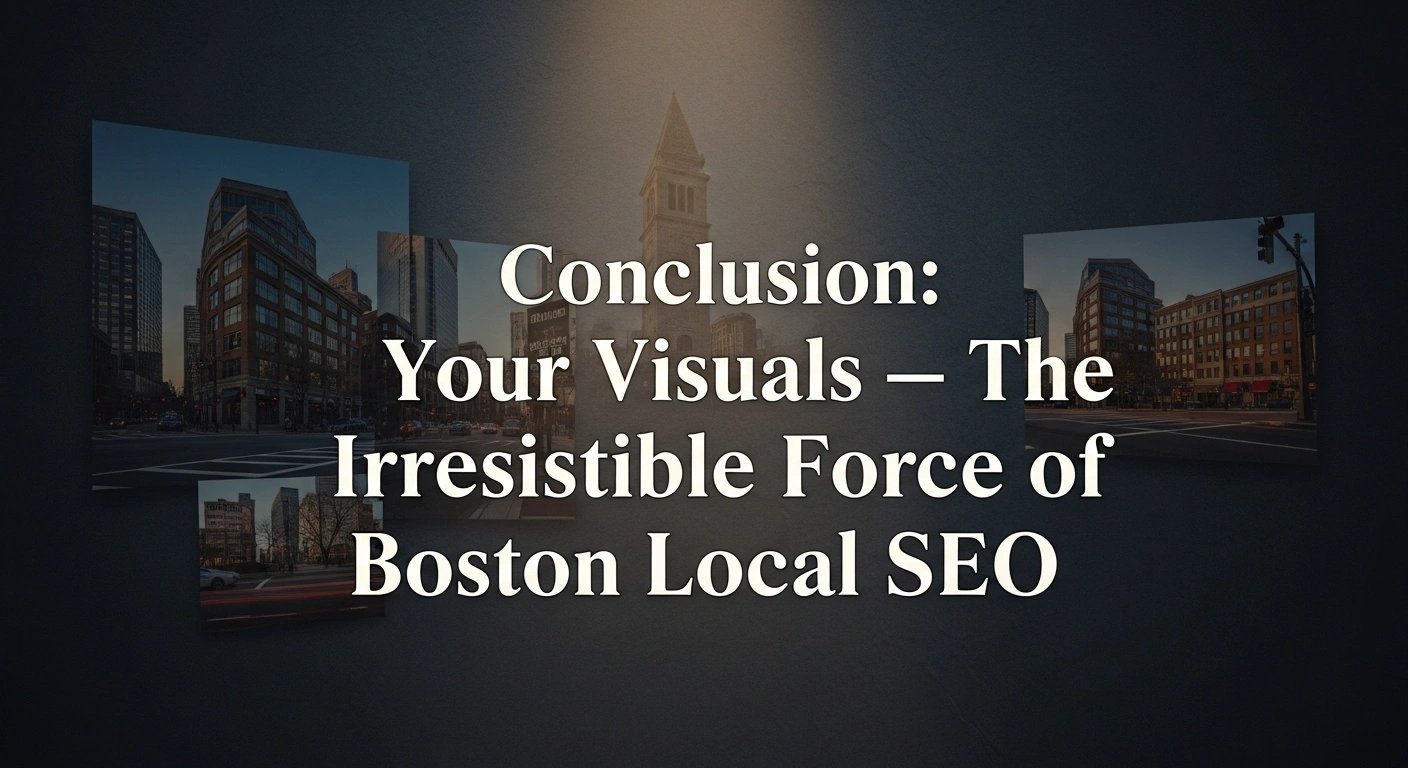
In the visually driven, AI-powered digital landscape of 2025, **visual dominance is no longer an aspiration; it is a strategic imperative** for Boston businesses seeking to thrive. Compelling photos, dynamic videos, and immersive virtual tours are your most potent tools for cutting through the noise, capturing immediate attention, and establishing deep, authentic trust with discerning Boston audiences. They are the silent, yet powerful, persuaders that translate online interest into tangible customer action.
By meticulously optimizing every visual asset—from your GBP’s vibrant photo gallery to your website’s high-performance imagery and engaging video content—you empower Google’s sophisticated AI to truly “see” and understand your business. This dedication to visual excellence directly enhances your prominence in local search results, profoundly strengthens your E-E-A-T signals, and creates an irresistible digital storefront that compels Bostonians to choose you over the competition. Leveraging AI in your content strategy, while maintaining a human touch and unwavering authenticity, ensures your visuals remain cutting-edge and impactful.
This comprehensive guide has equipped you with the blueprint for achieving visual dominance. But visuals, while powerful, need an audience. Next, we’ll delve into the unparalleled power of social media and community engagement, exploring how to leverage these platforms to connect directly with your Boston customers, build lasting relationships, and amplify your local SEO efforts for sustained growth in our vibrant city.
Is your Boston business’s visual content falling flat, or are you struggling to stand out in a crowded market? The experts at **seobostonma.com** specialize in crafting bespoke, data-driven visual content strategies that integrate seamlessly with Google’s latest algorithms and the unique aesthetic of Boston. We deliver measurable results for Boston businesses like yours. Schedule a free consultation with our team today and let’s transform your visuals into your most powerful local attraction and conversion tool, ensuring your business visually dominates the Boston landscape.


